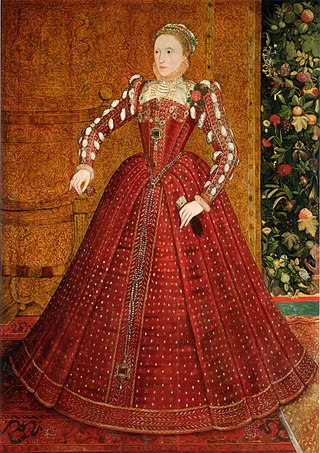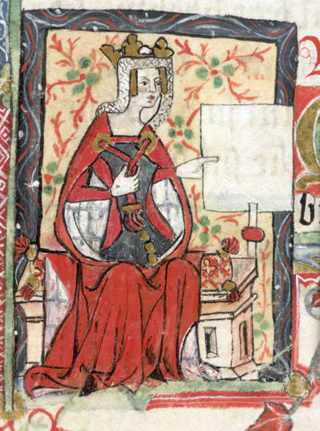
Mary II has been depicted in novels, film and television.

Mary II has been depicted in novels, film and television.
Copies of extant seventeenth-century broadside ballads about Mary II and William III, such as "England's Triumph" and "England's Happiness in the Crowning of William and Mary" are housed in Magdalene College's Pepys Library, the National Library of Scotland, and the British Library. [1] She is one of the monarchs listed in later versions of "The Wandering Jew's Chronicle".
Mary II appears as a character in Emma Marshall's 1894 novel Kensington Palace in the Days of Queen Mary II. She appears in Marjorie Bowen's historical novels about William III's life: I Will Maintain (1910), Defender of the Faith (1911), and God and the King (1911). [2] She is the protagonist of Jean Plaidy's novel 1992 novel William's Wife, later republished under the title The Queen's Devotion, and appears as in Plaidy's novel 1991 novel The Pleasures of Love (republished as The Merry Monarch's Wife), which focuses on Catherine of Braganza. Mary II also appears as a character in Neal Stephenson's The Baroque Cycle novels.
Mary II is portrayed by Sarah Crowden in the 1992 film Orlando , based on the novel by Virginia Woolf. Rebecca Front appears as Mary II in 1995 film England, My England , and Victoria Wood portrays her in 2005 film The League of Gentlemen's Apocalypse . She is portrayed by Ella-June Henrard in 2015 Dutch film Michiel de Ruyter .
She is portrayed by Lisa Daniely in the 1969 BBC television serial The First Churchills . [3] Louise Ford appeared as Mary II in series 6 and 7 of the 2015 revival of Horrible Histories .

Eleanor Alice Hibbert was an English writer of historical romances. She was a prolific writer who published several books a year in different literary genres, each genre under a different pen name: Jean Plaidy for fictionalized history of European royalty and the three volumes of her history of the Spanish Inquisition, Victoria Holt for gothic romances, and Philippa Carr for a multi-generational family saga. She also wrote light romances, crime novels, murder mysteries and thrillers under pseudonyms Eleanor Burford, Elbur Ford, Kathleen Kellow, Anna Percival, and Ellalice Tate.

Charles Brandon, 1st Duke of Suffolk was an English military leader and courtier. Through his third wife, Mary Tudor, he was brother-in-law to King Henry VIII.

Barbara Palmer, 1st Duchess of Cleveland, Countess of Castlemaine, was an English royal mistress of the Villiers family and perhaps the most notorious of the many mistresses of King Charles II of England, by whom she had five children, all of them acknowledged and subsequently ennobled. Barbara was the subject of many portraits, in particular by court painter Sir Peter Lely.

Elizabeth: The Golden Age is a 2007 biographical historical drama film directed by Shekhar Kapur and produced by Universal Pictures and Working Title Films. It stars Cate Blanchett in the title role and is a loose but fact-based portrayal of events during the latter part of the reign of Elizabeth I, forming a sequel to Kapur's 1998 film Elizabeth. The film co-stars Geoffrey Rush, Clive Owen, Jordi Mollà, Abbie Cornish, and Samantha Morton. The screenplay was written by William Nicholson and Michael Hirst, and the music score was composed by Craig Armstrong and A. R. Rahman. Guy Hendrix Dyas was the film's production designer and co-visual effects supervisor, and the costumes were created by Alexandra Byrne. The film was shot at Shepperton Studios and various locations around the United Kingdom.
The Bishop of Hereford is a character in the Robin Hood legend. He is typically portrayed as a wealthy and greedy clergyman who is robbed by Robin and his Merry Men.
Robin Hood's Chase is an English folk song about Robin Hood, and a sequel to "Robin Hood and Queen Katherine". This song has survived as, among other forms, a late seventeenth-century English broadside ballad. It is one of several ballads about the medieval folk hero that form part of the Child Ballads.

Elizabeth I of England has inspired artistic and cultural works for over four centuries. The following lists cover various media, enduring works of high art, and recent representations in popular culture, film and fiction. The entries represent portrayals that a reader has a reasonable chance of encountering rather than a complete catalogue.

Richard III of England has been depicted in literature and popular culture many times. In the Tudor period he was invariably portrayed as a villain, most famously in Shakespeare's play Richard III, but also in other literature of the period. Richard's life was not much depicted again until the 20th century when the "Ricardian" movement sought to restore his reputation. Much of more recent creative literature has portrayed him in a positive light. However his reputation as a hunchbacked villain has remained a familiar historical cliché within popular culture.
Edward IV of England has been depicted in popular culture a number of times.

Anne Boleyn, the second wife of King Henry VIII of England, and Queen of England from 1533 until she was beheaded in 1536 for treason, has inspired or been mentioned in many artistic and cultural works. The following lists cover various media, enduring works of high art, and recent representations in popular culture, film and fiction. The entries represent portrayals that a reader has a reasonable chance of encountering, rather than a complete catalogue.
George VI is depicted in art and popular culture.
Philip II of Spain has inspired artistic and cultural works for over four centuries, as the most powerful ruler in the Europe of his day, and subsequently a central figure in the "Black Legend" of Spanish power. The following list covers representations of him in drama, opera, film, novels, and verse. A small selection of the many artistic portrayals of Philip is shown in gallery form.

The 12th-century ruler Empress Matilda has been depicted in various cultural media.
The Wandering Jew's Chronicle is an English broadside ballad dating back to the 17th century, with The Wandering Jew as its narrator. From the point of view of the titular character, this ballad tells the history of the English monarchs, beginning with William the Conqueror, and continuing through King Charles II in early versions, and King George II in later versions. The ballad, according to Giles Bergel, dates back to an initial publication of 1634. Copies of the ballad can be found at the British Library and Magdalene College. Online facsimiles of the text are also available for public consumption.
England's Happiness in the Crowning of William and Mary is an English broadside ballad composed in 1689 and takes as its primary focus the coronation of William III and Mary II. William and Mary's joint reign began in February 1689 when the Convention Parliament, summoned by William after his invasion of England in 1689, offered him the crown. Though this ballad never comments explicitly on William and Mary's 1689 penning of the English Bill of Rights, it nevertheless focuses heavily on one specific component of the act, namely the reestablishment of Protestant liberty, as William III and Mary II were both Protestants: "For a Protestant King and a Protestant Queen, / The like in old England long time hath not been."
England's Triumph, Or, The Kingdom's Joy for the proclaiming of King William and His Royal Consort, Queen Mary, in the Throne of England, on the 13th. of this instant February. 1688, or simply England's Triumph, is an English broadside ballad composed in 1689. As the title suggests, the ballad takes as its primary focus the coronation of William III of England and his consort Mary II of England, which took place in February 1689. William III and Mary II's coregency marked the end of the Glorious Revolution and the reign of James II of England. The coregency also brought about a shift in the religious paradigm of 17th-century England, which was Roman Catholic when James II sat upon the throne. Indeed, the ballad comments on the "vile pop'ry" that ruled the throne prior to the rule of William III, which saw the restoration of Protestant liberty. Extant copies of the ballad are available at Magdalene College, Cambridge in the Pepys Library. Alternatively, online facsimiles of the ballad are available online for public consumption.
The Woeful Lamentation of Jane Shore is an English broadside ballad from the 17th century. It tells the story of Jane Shore, a mistress of King Edward IV, and her downfall after the death of Edward. Copies of the broadside can be found at the British Library, the University of Glasgow Library, and Magdalene College, Cambridge.

Isabella of France was Queen of England and the daughter of Philip IV of France. Sometimes called the "She-Wolf of France", she was a key figure in the rebellion which deposed her husband, Edward II of England, in favor of their eldest son Edward III. This event, as well as Isabella's affair with Roger Mortimer and Edward II's relationships with Piers Gaveston and Hugh Despenser the Younger, have prompted Isabella's portrayal multiple times in literature and visual media.
William Marshal, 1st Earl of Pembroke was an Anglo-Norman soldier and statesman. He served five English kings – Henry II, his sons the "Young King" Henry, Richard I, and John, and John's son Henry III.